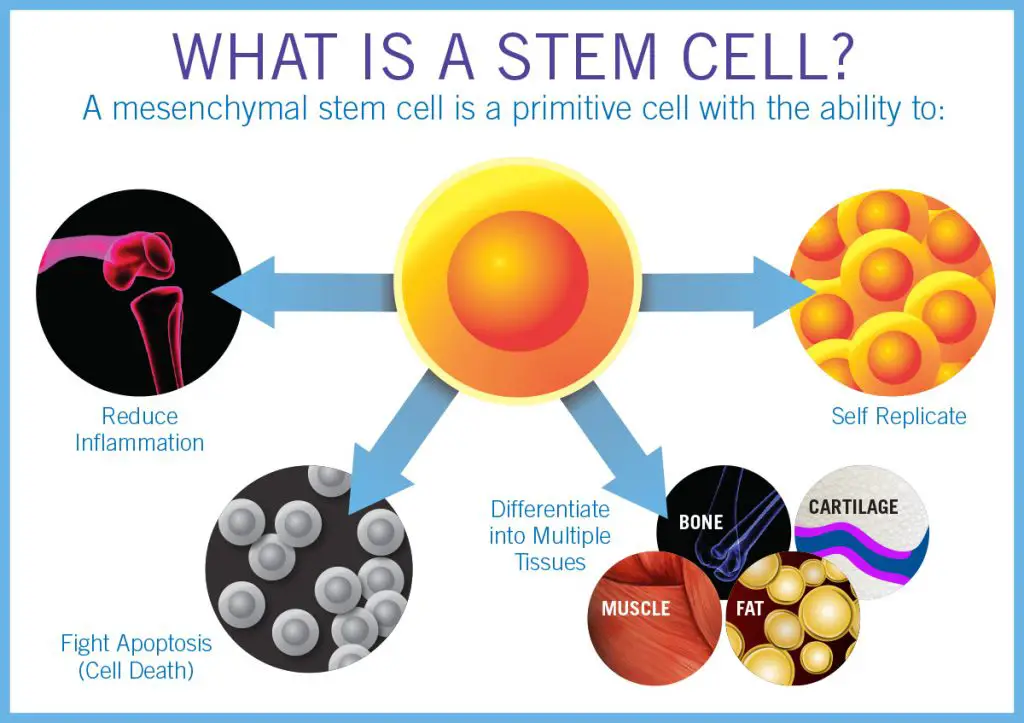Osteoarthritis is a debilitating condition that is also very expensive and becoming one of the most common types of arthritis in the elderly and young athletes. Obesity is a significant risk factor, and in the coming decades, health authorities predict a rise of osteoarthritis due to an increase in obesity rates.

There are various methods to treat the symptoms and progression of osteoarthritis. Pharmacologic management is common, and some patients may require surgical interventions, such as total knee arthroplasty.
Regenerative stem cell therapy is a type of treatment that uses a variety of cells with the ability to create new tissue and reverse joint damage. Among the tissues targeted by stem cell therapy, we have the cartilages, tendons, ligaments, muscles, and even the bone tissue. The goal is to regenerate joint tissues by using adult stem cells that modulate and replace the diseased tissue and improve any deficiencies of the joint.
But, is it possible to cure osteoarthritis with the current methods of stem cell therapy?
Regenerating cartilage tissue with stem cells
According to a review of the scientific literature on stem cell treatment for osteoarthritis, it is a very safe treatment for this condition. The authors of this study, published in the journal Osteoarthritis and Cartilage, stem cell treatment is likely to have a positive effect in patients with osteoarthritis, but the outcome of the treatment depends on various factors, and there are not always consistent results in terms of efficacy. One of the reasons why stem cell treatment yields variable results is that there’s not a single type of cartilage tissue inside the joints.

We do know that mesenchymal stem cells propagate and differentiate in chondrogenic cells. These cells create the cartilage tissue, and it was a very promising treatment because it worked in vitro, but in vivo cartilage behaves differently from in vitro settings. A mesenchymal stem cell that forms cartilage in vitro does not always form healthy cartilage in vivo because the behavior of cartilage in a living being depends on pressure points, functions of each compartment, and the susceptibility of cartilage to mechanical insults. Moreover, different stem cell pools likely create different cartilage structures with varying features.
To book an appointment in the UK for Stem Cell Treatment for Osteoarthritis we recommend The Regenerative Clinic.
This variation in real-life poses a great challenge, and it is the reason why patients experience different results that won’t be easy to reproduce in every single case. Osteoarthritis features degradation of the bone and cartilage tissues in varying degrees and with characteristics that depend on each patient and the causes that triggered the disease in the first place. Still, there are studies in humans with promising results and science is striving to take a step forward in the treatment of osteoarthritis with stem cells.
Evidence for the Effectiveness of Stem cell Treatment combating Osteoarthritis
Despite the challenges, many groups of researchers have found success in treating osteoarthritis with stem cells. In the pilot study, developed by investigators from the Krembil Research Institute in Canada, 12 participants with osteoarthritis received three different doses of mesenchymal stem cells and were evaluated after 12 months to detect any change in their symptoms and inflammatory biomarkers. Among other studies, they performed MRI scans to assess the structures of the affected joints and evaluated the symptoms with standardized tests. They reported a significant improvement in the quality of life, a reduction in the pain score, and no serious adverse effects. The rate of inflammation was reduced in the knee joint, which may explain the significant decrease in pain and the improvements in joint function.
Combating Osteoarthritis through Stem Cell Therapy Research
with thanks www.ncbi.nlm.nih.gov
After this initial trial, other studies have been made in larger cohorts. All of these studies agree that stem cell treatment is safe and improves the symptoms of the patients in varying degrees. However, not all patients have the same prognosis, and the effectivity of the treatment is still called into question. Even the pilot study, which reported significant improvements in osteoarthritis, did not report any improvement in the cartilage after one year. Later studies showed similar results, but all of them are small-scale studies, and we do need more data from larger cohorts in order to evaluate the effects of stem cells in osteoarthritis and make it available as standard therapy in the future.
Which stem cell variant is more appropriate for osteoarthritis?
Among the challenges to adopting stem cells as a standard treatment for osteoarthritis, we need to clear out which stem cell variant is more appropriate for these patients. Here are a few options that researchers have for upcoming studies with stem cells in osteoarthritis:
- Mesenchymal stem cells: They were initially used in the pilot study and many others because this group of cells creates a wide variety of tissues, including cartilage tissue and bone. These cells are isolated from the bone marrow and characterized by their membrane proteins. Each subtype has different differentiation potentials and renewal capabilities, which makes things a bit more complex in the clinical practice.
- Induced pluripotent stem cells: These stem cells are capable of proliferating without undergoing differentiation. Then, we can induce them and make them differentiate into chondrocytes to create cartilage. It is apparently a fitting choice because they were successfully tested in other diseases, but induced pluripotent stem cells remain to be investigated in osteoarthritis.
- Skeletal stem/progenitor cells: These progenitor cells can be found in the surface zone of human articular cartilage and bovine cartilage. They are similar to mesenchymal stem cells but need further studies to identify the exact population that needs to be used in case of osteoarthritis.
- Regulation of endogenous chondrogenesis: Another option that may become the future of stem cell treatment in osteoarthritis is stimulating and regulating endogenous chondrogenesis within the resident stem cell populations in the cartilage. We can achieve that with regional growth factors, but more studies are needed to understand the exact mechanism behind the regeneration of the articular cartilage.
In a nutshell, stem cell therapy is still in a developing phase and seems to be a promising treatment option for osteoarthritis. It is very safe and improves inflammation, pain symptoms, and quality of life of patients. However, this treatment does not always have the same result, and more studies are needed to figure out the best way to use stem cells for regenerative purposes.
References:
Ng, J., Little, C. B., Woods, S., Whittle, S., Lee, F. Y., Gronthos, S., … & Worthley, D. L. (2019). Stem Cell Directed Therapies for Osteoarthritis: the promise and the practice: Concise Review. STEM CELLS.
Lin, K. (2020). Short Review on the Advancement of Osteoarthritis Treatment with Cell Therapy. J Regen Biol Med, 2(1), 1-7.
Chahal, J., Gómez‐Aristizábal, A., Shestopaloff, K., Bhatt, S., Chaboureau, A., Fazio, A., … & Kapoor, M. (2019). Bone marrow mesenchymal stromal cell treatment in patients with osteoarthritis results in overall improvement in pain and symptoms and reduces synovial inflammation. Stem cells translational medicine, 8(8), 746-757.
